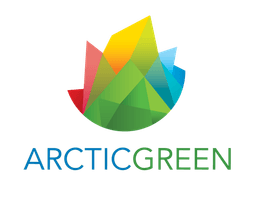
About us
Our Businesses
Projects
Partnership Summit
News
Insights
Contact Us
Energy
What is Geothermal Energy
GEOTHERMAL ENERGY is the heat generated by the earth’s core. The earth’s core is approximately 6,000°C, the same temperature as the surface of the sun, and is constantly radiating heat outward. This heat warms the rocks, water, gas, and other geological material within the earth’s crust where we can capture it. Geothermal energy is renewable and can be found almost anywhere in the world, from shallow ground to deep under the surface. When captured, geothermal can be used to generate electricity, heating, and cooling and a multitude of other applications.
HOW GEOTHERMAL ENERGY IS CAPTURED Fundamentally, geothermal energy can be captured through three methods depending upon where the energy is stored within the earth’s crust. Energy stored near the surface can be easily accessed with geothermal heat pumps. These heat pumps take advantage of the earth’s naturally consistent temperature at shallow levels to pump heating/cooling to a single building or small city block.
If the energy is deeper in the earth’s crust (as most geothermal energy is), we access it through drilling. The first drilling methodology, conventional hydrothermal, involves drilling into underground hot water reservoirs 1km to 4km below the earth’s surface. Hot water is brought to the surface through production wells and passed through geothermal heat exchangers or turbines to harness the energy.
The other primary drilling methodology is called Enhanced Geothermal Systems (EGS). These systems rely on site developers creating their own underground hot water reservoirs to tap into the earth’s heat. Developers drill into the earth and inject pressurized water to be heated by the earth and then exact that hot water to capture the energy. Keep reading for more nuances of these capture methodologies and associated technologies.
HOW IT IS UTILIZED Geothermal energy can be utilized for direct use applications such as heating/cooling, agriculture, aquaculture, and industrial processes or it can be utilized to generate electricity. The appropriate application for geothermal energy depends on the temperature of the water extracted from the ground. For example, heating and cooling small structures with heat pumps only require low-temperature water (down to 10-30°C). Meanwhile, heating and cooling whole district systems require more medium-temperature water accessible via drilling.
Electricity generation requires the highest geothermal temperatures, with traditional methodologies requiring super-heated steam above 150 °C to drive turbines and produce green electricity. Advanced binary system technologies are emerging to lower the temperature required to generate electricity and may be scalable in the near future.
The temperature and flow rates (and resulting applications) of a particular geothermal resource can be difficult to accurately predict. Each geothermal drilling site is unique, and there is no formula that produces an exact temperature in any location. The characteristics of the specific well, quality of the reservoir, and depth of drilling all impact the temperature potential and its possible applications.
WHY IT IS IMPORTANT Geothermal is a carbon-free, renewable energy source with endless quantities available just below our feet. Scientists estimate just 0.1% of the heat content of the earth could supply humanity’s total energy needs for millions of years. Put differently, geothermal can power all human civilization for generations without the devastating impacts of carbon emissions on our populations and ecosystems. All we have to do is capture it.
At Arctic Green, we believe geothermal energy utilization will play a significant role in the world’s fight against climate change and air pollution. We are showing the scalability of geothermal district heating systems to heat our cities reliably, economically, and with no damage to the environment.

Photo Source: US Department of Energy

Photo Source: Geovision
District Heating with Geothermal
District heating utilizes the heat from geothermal reservoirs that are piped to the surface. The hot groundwater is then used to heat buildings. After the heat has been used, the water is returned back into the ground to be reheated and then used again and again in the cycle.
The system is a fully renewable, closed loop creating a no-carbon, sustainable heating solution.
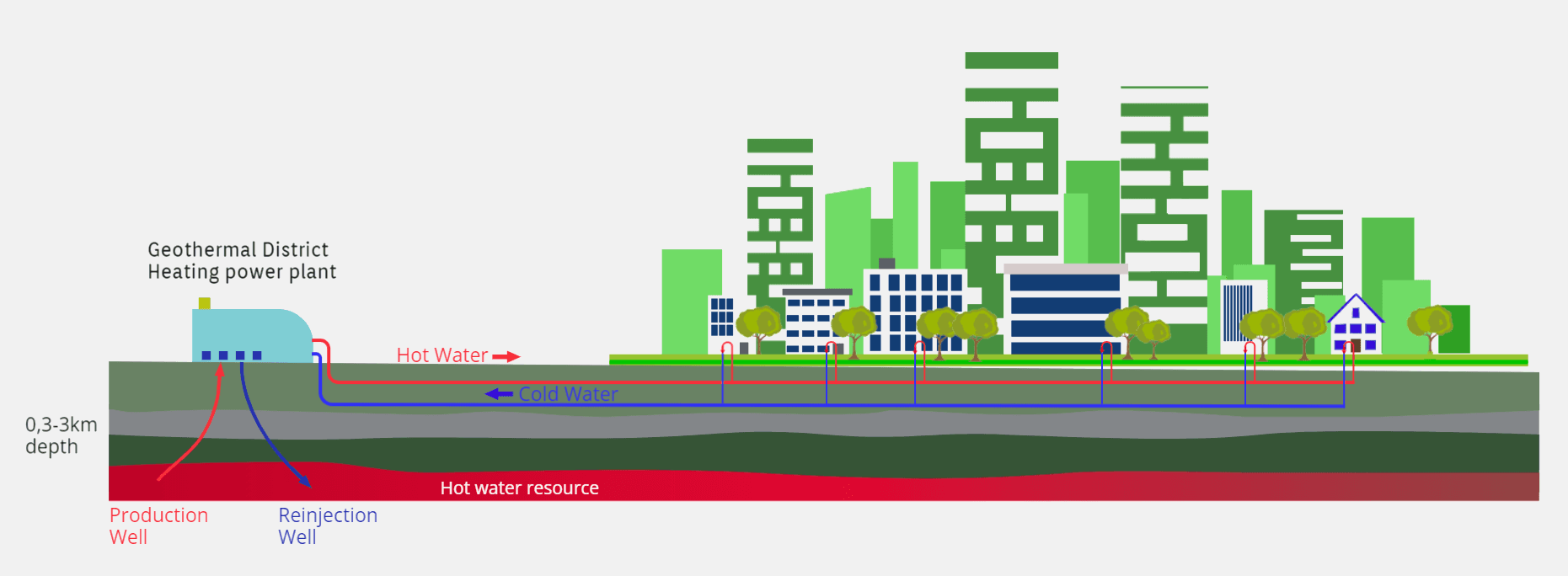
Geothermal in Urban Planning
Geothermal energy systems can be effectively hidden in the urban landscape with careful planning and design, preserving the aesthetics of the city while still reaping the benefits of a sustainable energy source.
Geothermal systems can be integrated into the design of buildings. For example, heat exchangers and pumps can be concealed within basements, mechanical rooms or parking garages leaving only vents or grills needed for air circulation visible.
The picture shows an aluminum structure built around a 1,360m deep well drilled in 1960. In 2021, the well was re-drilled for maintenance. The well is located in the parking lot of the Nasdaq Iceland Stock Exchange in Reykjavik, Iceland.
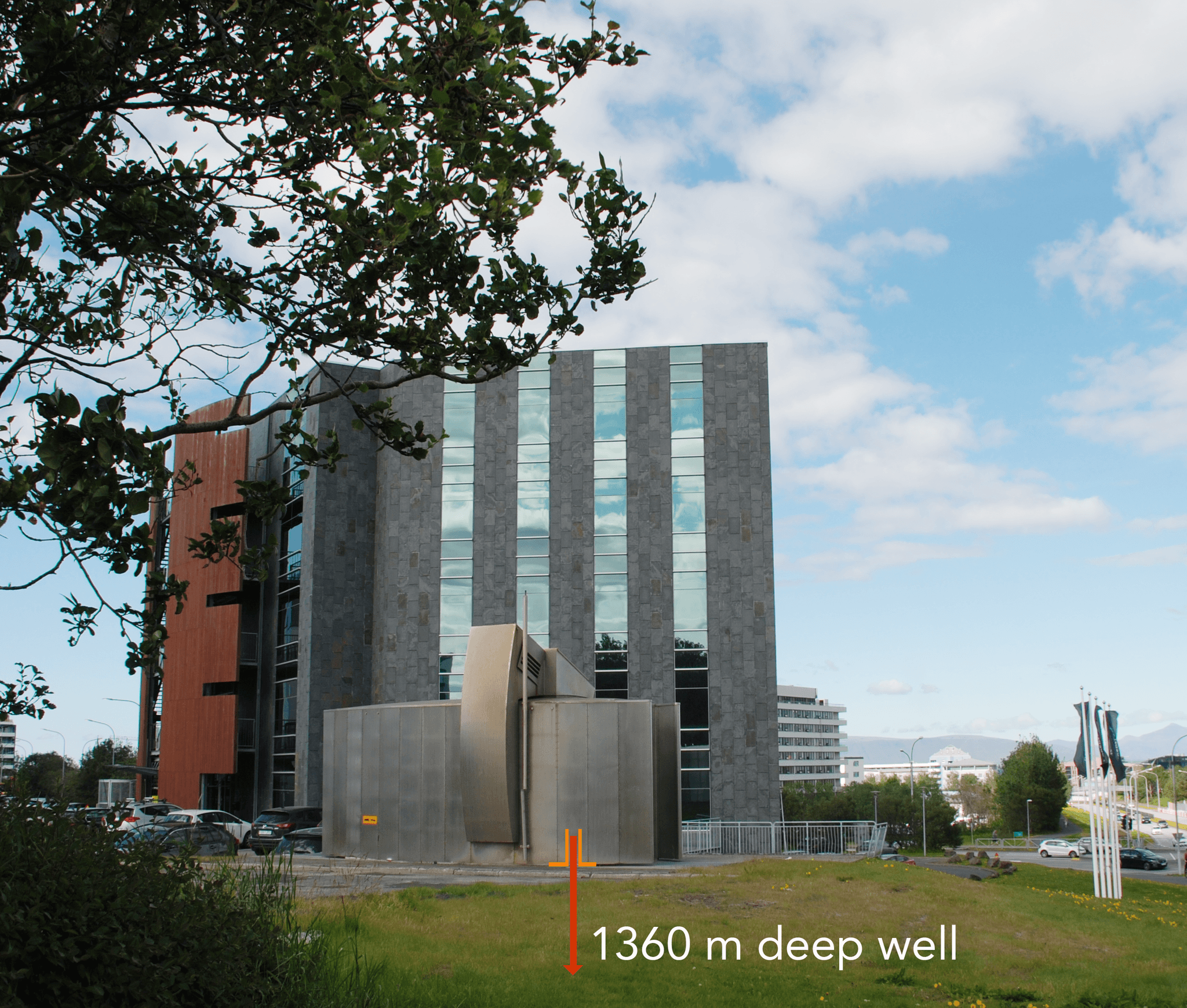
Benefits of geothermal
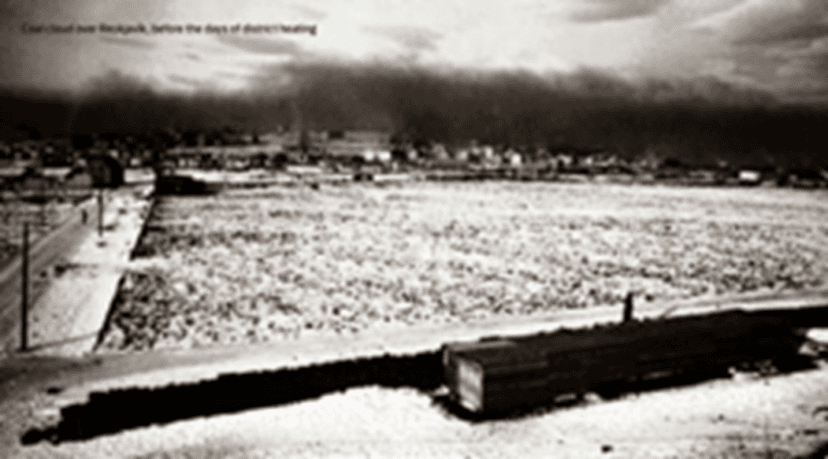
Reykjavik before geothermal
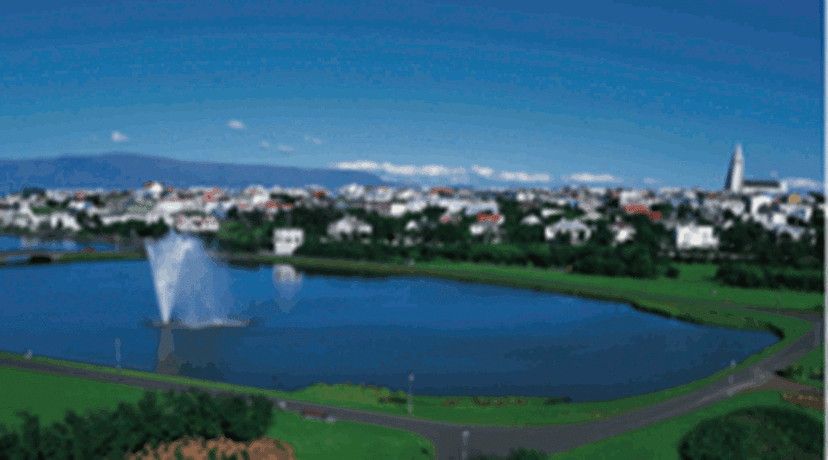
Reykjavik after geothermal
The Icelandic Model
Where does the geothermal experience in Iceland come from? To answer this question, it is necessary to look at the long history of energy utilization in Iceland. Iceland has long been a global leader in renewable energy and was an early adopter of geothermal. In 2008, the country celebrated 100 years of geothermal district heating. This long tradition of geothermal utilization for heating and later for electricity production began in 1969 and has continued today, enabling Icelandic geologists, engineers, and geothermal utilities to develop world-leading expertise. Iceland boasts impressive statistics in renewable energy utilization. 82% of Iceland’s primary energy usage is derived from renewable sources, while 100% of all electricity is produced from renewables (30% geothermal and 70% hydropower). Nowhere else does geothermal energy play a greater role in a nation's energy supply and overall prosperity.
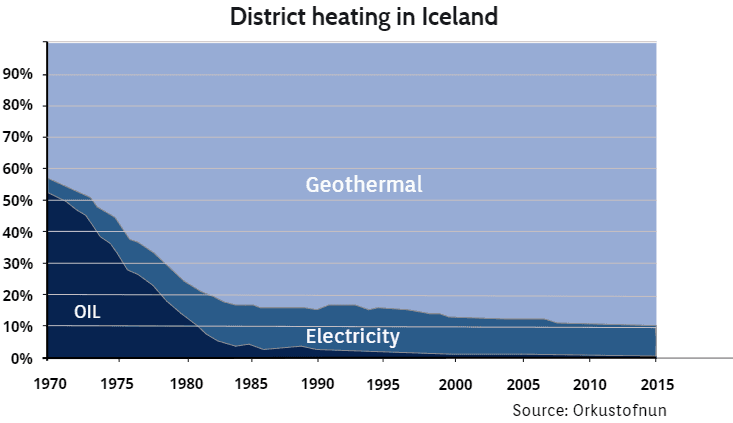
Comparison with other Renewables
Geothermal is one of many tools in the renewable sector that can help us move towards a cleaner planet and brighter future. Geothermal is generally less understood and less invested in than other renewables with around 1% of the world’s energy being derived by it. The sector is still emerging and key technologies in cost-effective drilling and capture are developing. As companies like Arctic Green prove geothermal’s benefits and scalability, the industry will continue to expand.
Geothermal has two key differentiators from other renewables that add to its appeal:
- It is the only renewable baseload energy. It is not reliant on the weather, sun, wind, or water flow to produce consistent generation. Geothermal’s constant availability at consistent rates is incredibly useful to reliably power and heat our cities.
- Geothermal energy has cascading usage. This means that the heat produced can be re-used for more than one application. While the highest heat can be used to produce electricity and green hydrogen, excess heat can be used for other applications with lower ideal temperatures, like direct-use heating and cooling, agriculture, aquaculture, etc. The cascading usage of geothermal makes it one of the most efficient renewable energies.


Different types of geothermal technology
Geothermal heat pumps
Heat pump technology relies on the relatively constant temperature all year round of the shallow earth right below the surface. The temperature is warmer than the air during the winter and cooler during the summer, acting as a source or sink of heat depending on the season. Ground source heat pumps use some electricity to pump liquid through underground loop systems and then extract the heat energy for heating and cooling applications. The electricity required to operate heat pumps can come from the local electrical grid or green sources. Today’s advanced heat pumps are highly efficient with an output: input COP ratio of 6:1. In recent years, great progress has been made in industrial-size heat pumps with drilling fields with multiple shallow wells, often hundreds drilled in a grid, up to 200 meters deep.
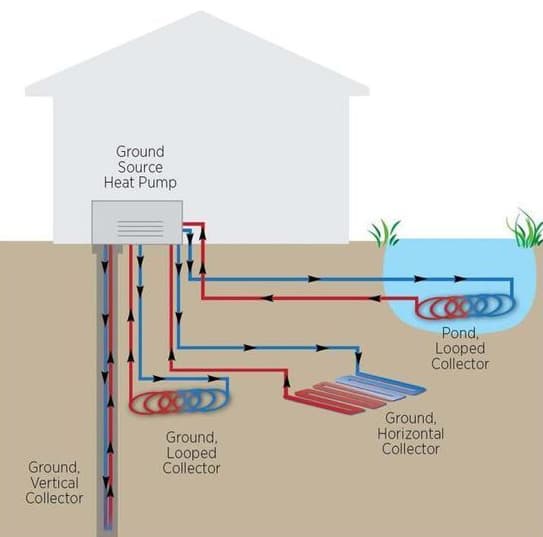
Photo Source: University of Boras
Hydrothermal geothermal
Hydrothermal drilling technology makes use of natural underground hot water reservoirs trapped in permeable rock. Heated by the earth’s core, water rises through rock fissures and fractures and becomes trapped under solid caprocks. This forms natural reservoirs of pressurized hot water. These reservoirs often reveal themselves through hot springs or fumaroles. Once a reservoir is located, developers drill exploratory wells to map the field and then drill production wells to extract the hot water. The water’s heat is captured using heat exchangers or turbines, and the remaining fluids are returned to the field through re-injection wells to maintain reservoir pressure. These wells are typically 1-4km in depth and produce temperatures of 55 °C to over 150 °C depending on the quality of the site. As a rule of thumb, the Earth’s heat gradient rises 30°C for every km of increased depth.
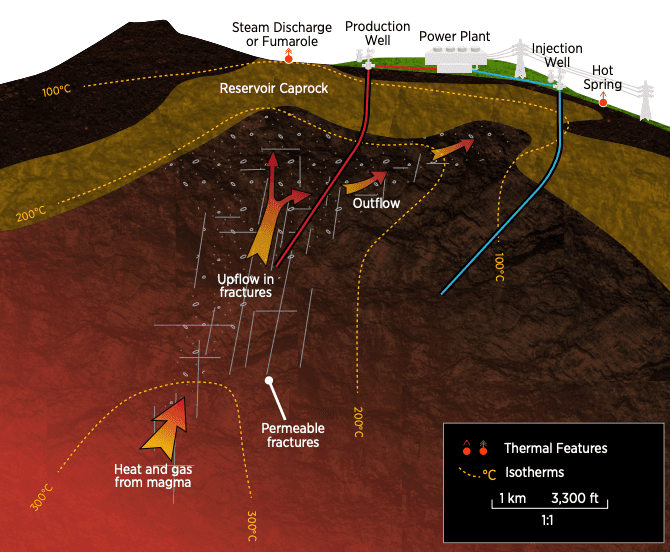
Photo Source: US Department of Energy
Enhanced Geothermal Systems (EGS)
Developers can make enhanced geothermal systems by effectively creating underground hot water reservoirs from solid rock. Developers drill into solid rock and inject water and geothermal brine at high pressure. This fractures the rock and allows fluid to permeate and become heated. The hot fluid is then extracted through the production well, and the heat is captured. Remaining fluid is re-injected, restarting the process again. The effectiveness of an EGS is based upon the site’s reservoir permeability, temperature, well permeability, and depth. Enhanced drilling technology can increase the productivity of a site by branching out from “in field” into “near field” resources. This horizontal drilling increases the amount of permeable rock, allowing more fluid to be heated and extracted.
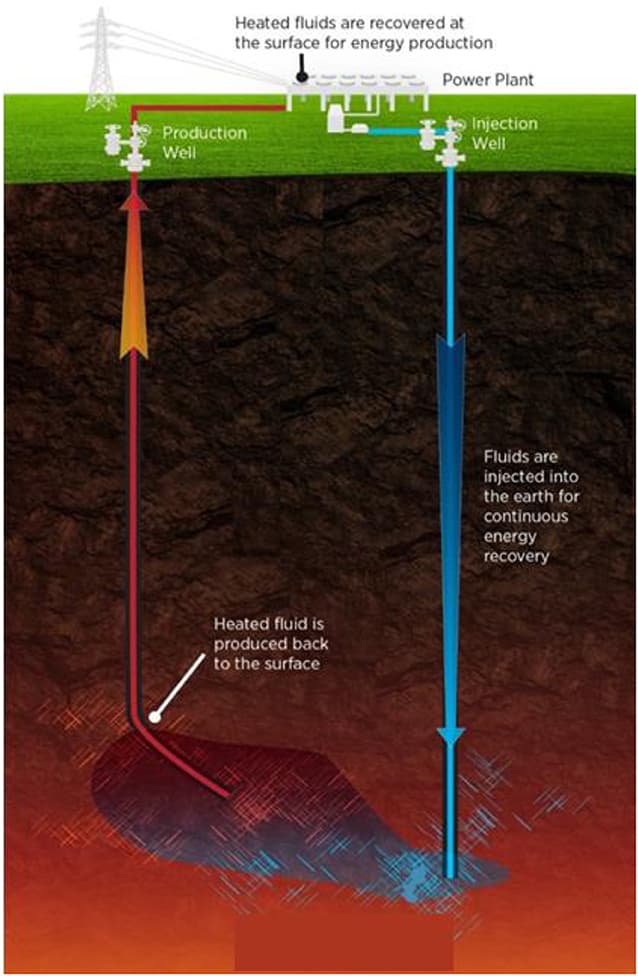
Photo Source: US Department of Energy
Hot Rock Geothermal (DEEP EGS)
Hot rock geothermal relies on the principles of EGS but explores heat sources at much greater depths and temperatures. Hot rock geothermal drills at least 6 miles beneath the surface where water temperatures exceed the “supercritical” 373ºC threshold. These wells create significantly more energy than traditional EGS wells. A hot rock geothermal project at 400°C can produce ~50MW capacity, compared to roughly 5MW capacity of an EGS project at 200°C — 42 percent hotter, 10 times the power. While these energy enhancements are appealing, hot rock technology with such deep drilling is still developing. Engineering and profitability concerns need to be resolved before this technology is scalable.
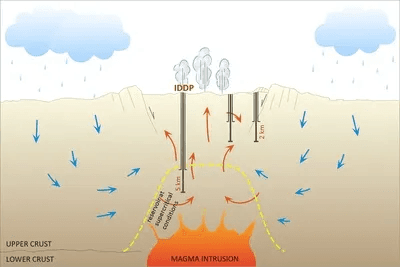
Photo Source: National Energy Authority of Iceland
Advanced Geothermal Systems (AGS)
This new, emerging technology relies on the concept of an engineered renewable closed loop. Instead of water being extracted from and injected into the earth, fluid moves through man-made underground pipes in the shape of a loop. The fluid assumes the earth’s heat and returns to the surface where the heat is captured using turbines. AGS could potentially supply both electricity and heating and cooling applications. Advocates maintain that AGS may one day surpass EGS because it eliminates any fracking concerns associated with the latter. However promising, AGS has not been proven yet. Advances in drilling and depth exploration are being made every year to make these systems possible.

Photo Source: GreenFire Energy
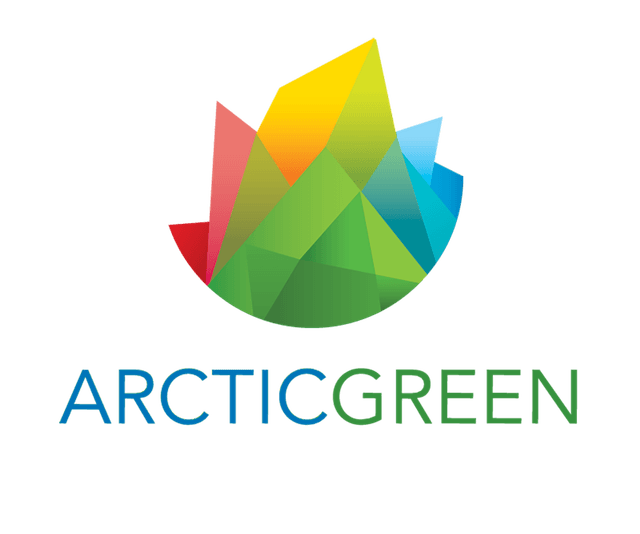
Info@ArcticGreen.com
Our Offices